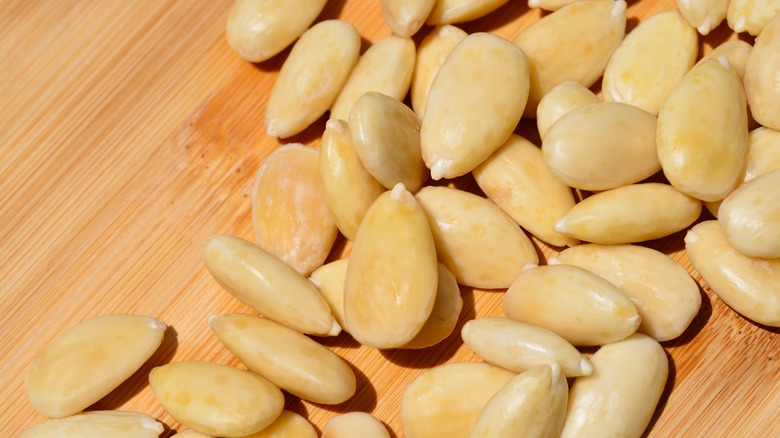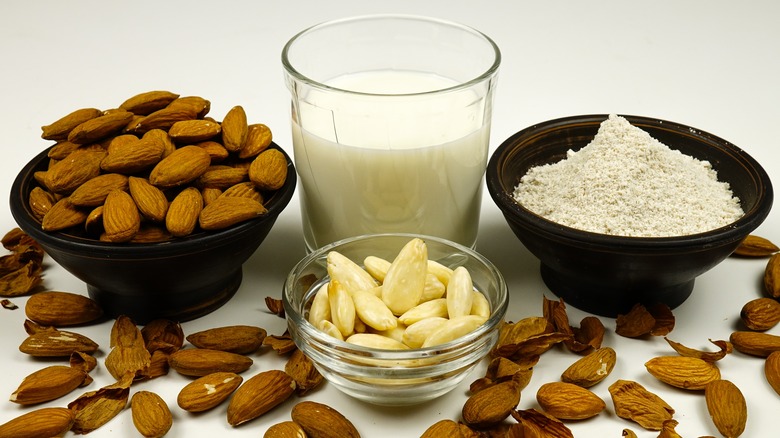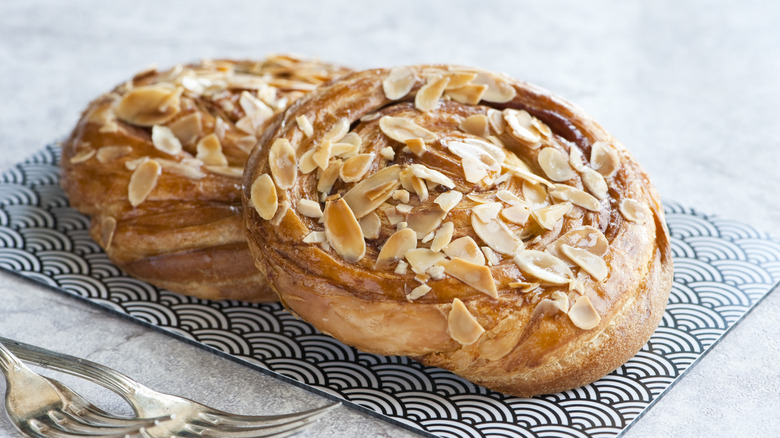How To Easily Remove The Skin Off Of Almonds
It can be a chore to remove the skin from almonds, but there's a simple technique that makes it a breeze: blanching. This method involves briefly heating the nuts and rapidly cooling them immediately after. The process is simple — start by bringing a pot of water to a rolling boil, then add the almonds and cook for no more than 60 seconds. Next, transfer them to a bowl of ice water and let them chill for another minute to halt the cooking process.
In just a few minutes, magic will occur, as the almond's skin will start to detach from its inner flesh after softening from the water. Next, pick up a cooled-off almond and pinch it between two fingers, and the skin will slip off like a glove. This is cleaner and quicker than roasting, freezing, or scratching the skin off with no prep, and it's also a great option when you're working with large batches of almonds — in no time, you'll have a pile of smooth, skinless nuts ready for any use.
This method also preserves the almond's shape, since it won't get bloated from soaking in water, or shrink from roasting. It maintains the nut's original firmness and texture, as well, because it's only exposed to water for a few minutes. Blanching is the perfect option when you need uncooked almonds that retain their smooth and natural appearance.
Why bother to remove the almond skins?
Why bother to remove an almond's skin? Firstly, it can be somewhat bitter and hard to chew, which isn't ideal for the flavor and texture of certain dishes. And if you have a sensitive digestive system, almond skins may be challenging to break down due to their high concentration of tannins, a bitter compound that may lead to an upset stomach or nausea in some individuals. They also contain a significant amount of oxalic acid, a natural compound found in plants that is harmless in small amounts, but may cause kidney stones and poor nutrient absorption in larger doses. Blanching almonds removes a portion of their oxalic acid, reducing these risks.
Another reason to opt for peeled almonds is to accommodate delicate recipes that can't stand up to the bitterness that the skins impart. This includes almond butter, almond flour, and baked goods like macarons. Almond milk is also best when made with blanched almonds, resulting in a sweet, nutty flavor without the tannic bite. Skinless almonds also make for a finer texture and a less grainy mouthfeel in recipes, letting the nut's buttery and mild flavor shine through.
That said, almond skins aren't without their benefits. They contain a lot of fiber, as well as important nutrients like vitamin E. The skins also contain polyphenols, known for their anti-inflammatory and antioxidative benefits. Still, there's plenty of nutritional value in the almond's flesh and a good amount of protein, so you're still consuming healthy food when indulging in the peeled version.
Creative ways to use your blanched almonds
Skinless almonds have plenty of culinary uses that can elevate both sweet and savory dishes. One of the most popular ways to use them is to toast them and lightly dress with flavorings like olive oil, salt, garlic, onion, and savory herbs. You can snack on these alone or add them to dishes like this smoky kale salad for an extra crunch and a hit of nuttiness.
In the world of confections, skinless almonds are used to make marzipan, a sweet almond paste commonly used in (or on top of) cakes and pastries. It's also the base for frangipane, an almond-y filling used in tarts. This apple almond tart recipe uses whole almonds ground into a filling, which may have a lighter and brighter flavor when the nuts are blanched in advance.
Cuisines around the globe also feature blanched almonds in beloved dishes. The skinless nut particularly stands out in traditional Mediterranean dishes like the pepper and tomato-based Romesco sauce, or Italian amaretti cookies. Blanched almonds are also a beloved ingredient in Indian sweets, such as badam burfi, a fudge made from blanched almond flour, sugar, ghee, and cardamom powder. In short, blanched almonds are universally beloved and, thankfully, easy to make.



